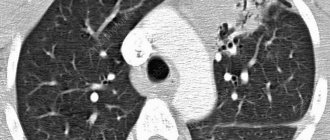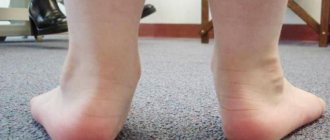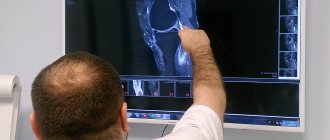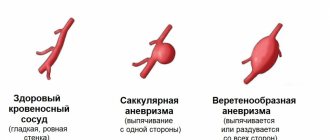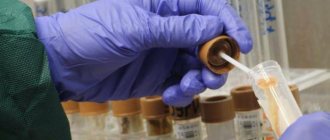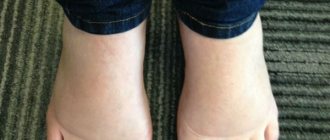What is edema?
This is an accumulation of fluid in tissues. We begin to see and feel swelling when there is a lot of this fluid.
- Most often, discomfort in the legs increases in proportion to the time spent in an upright position. It especially manifests itself in the late afternoon (it also happens differently, it all depends on the cause of fluid retention).
- The legs become heavy, get tired faster, and begin to hurt.
- A characteristic swelling appears in different parts of the lower extremities from the feet to the knees. It is preceded by a feeling of “tight shoes” and marks from socks and golf shoes or from finger pressure.
- If the swelling is prolonged and significant, the color and plasticity of the skin may change until cracks and wounds appear. Pain is felt when pressing (or even lightly touching) the swollen limb.
What kind of liquid is this?
Water? Yes and no. This is a derivative of blood plasma - the so-called. tissue (intercellular) fluid. Water is included in its composition. But besides it, there are also salts, proteins, sugars, lipids, dissolved gases, etc. In different organs and tissues, its composition has its own nuances.
Do tissues need this liquid? How necessary! Vitally necessary! After all, this is their habitat. It nourishes, protects, cleanses, and supplies oxygen to the cells living in it. It is not for nothing that there is several times more of it in our body than blood. In essence, the intercellular fluid is for cells what the world ocean is for its single-celled inhabitants.
This “habitat” is constantly renewed. New fresh portions come from the blood to the tissues; the old ones return to the bloodstream (directly or indirectly through the lymphatic system) to again undergo the “rite” of cleansing from waste and saturating the cells with vital elements. Stagnation of tissue fluid is both a consequence and a cause of diseases (including edema), and is dangerous for cells.
How is it formed?
It is filtered through the walls of the smallest blood vessels - capillaries (in the arterial part) into the intercellular space. In a normal day, about twenty liters of liquid penetrate from the capillaries into the tissues! The cells of an organ or tissue, in turn, also participate in its production, releasing the products of their vital activity.
What determines the speed and scale of replenishment of intercellular fluid reserves?
- From the blood pressure at the arterial end of the capillary.
- From the permeability of its wall.
- From the saturation of both blood in the capillary and tissue fluid with various substances (proteins, salts).
- On the timeliness and effectiveness of returning tissue fluid to the bloodstream.
It returns back to the blood in two ways:
- most of it enters the venous part of the capillary;
- the smaller one goes into the lymphatic capillaries.
But in the end, all of it ends up in the blood, since the vessels of the lymphatic system flow into large veins.
Obstacles to the return of tissue fluid to the blood can be of both physical and chemical nature:
- partial or complete obstruction of veins and/or lymph vessels;
- injuries accompanied by the accumulation of fluid in the tissues (this is a natural defensive reaction aimed at protecting and speedy restoration of damaged structures);
- low concentration of proteins in the blood plasma (in this case, the liquid, obeying the laws of osmosis, is in no hurry to leave the tissue space);
- venous congestion caused by weakness of the valvular apparatus of the veins, prolonged exercise (especially static), weakness and/or low activity of the leg muscles, heart failure, etc.
In a healthy body, the processes of fluid transfer into tissues and back are coordinated and are in a state of dynamic equilibrium. That is, the more it goes in, the more it comes back. If for some reason the outflow of fluid is impaired, swelling occurs.
Let's look at these reasons.
Why do my feet swell?
The first group of causes includes severe chronic illnesses: diseases of the cardiovascular and digestive systems, kidneys, liver, endocrine and autoimmune pathologies.
In this case, several mechanisms regulating the distribution of fluid in the body and its removal to the outside are affected. And edema forms not only in the legs, but also in other organs and tissues (pleural and abdominal cavity, pericardial sac, face, etc.).
For example:
- Protracted liver pathology (cirrhosis) leads to impaired protein formation and a decrease in its content in the blood plasma. For this reason, fluid is retained in the tissues.
- Acute and chronic kidney damage (glomerulonephritis, systemic lupus erythematosus, etc.), accompanied by the so-called. Nephrotic syndrome also occurs with a pronounced impairment of fluid removal from the body. One of the mechanisms of fluid retention is again associated with a lack of protein in the blood. Only, unlike liver diseases, in this case the cause is the loss of protein in the urine (normally it should not leave the body in this way at all). It's not just the legs that swell. The accumulation of fluid is generalized.
- Cardiovascular diseases accompanied by progressive heart failure (coronary heart disease, hypertension, heart defects, arrhythmias, myocarditis, etc.). In this case, fluid retention in the tissues is provoked by several factors: a decrease in the force of cardiac output, a violation of venous and lymphatic outflow, the activation of compensatory mechanisms for maintaining a sufficient blood volume (since the fluid leaves from there and accumulates in the tissues) due to the retention of salts and water, etc. T. That is, some disturbances in the functioning of the body set into motion mechanisms that are initially designed to compensate for them, but ultimately lead to a worsening of the situation. This is a very common cause of leg swelling.
- Separately, it is worth noting not so much the disease as the hormonal imbalance, including that manifested by periodic fluid retention (and in the legs too). This is the so-called premenstrual syndrome. One of the mechanisms for the appearance of edema is considered to be a temporary decrease in the permeability of the vascular wall, mediated by sex hormones, facilitating the release of fluid into the tissue.
Swelling of the legs, not accompanied by accumulation of fluid in other organs and tissues, can occur due to:
- Local traumatic injuries (mechanical, thermal, chemical, infectious), leading to tissue inflammation. The inflammatory reaction is accompanied by a violation of the integrity and/or increased permeability of the vascular wall and, as a consequence, the release of a large amount of blood plasma into the tissue. This is a protective reaction to help cope with damage.
- The same mechanism for the formation of edema is also inherent in local allergic reactions (for example, in response to insect or reptile bites).
- The presence of obstructions in the venous and/or lymphatic system that prevent fluid from leaving the lower part of the body. For example, blood clots in the veins due to thrombophlebitis or inflammatory damage to the lymph vessels.
- Lesions of the central and peripheral nervous system, leading to disruption of the regulation of vascular tone and leg muscle function. In this case, the swelling most often affects one limb. Paralysis of one or both legs may also be accompanied by excess fluid accumulation.
- Venous insufficiency (with varicose veins and not only). Let's look at this reason in more detail.
It manifests itself as overstretching of the walls of venous vessels and weakness of their valve apparatus. Healthy vascular tone and effective valves are the key to successful blood overcoming gravity, which prevents it from rising to the heart. Moreover, the heart itself ensures the release of blood to a greater extent than its return.
What can weaken the work of these natural "lifting mechanisms"?
- Excess body weight.
- Muscle weakness due to illness or sedentary lifestyle.
- Physical overload (for example, in athletes).
- Long-term static loads (long standing on your feet without active movement).
- Pregnancy.
- Hormonal changes.
- Long-term use of medications that change blood viscosity and vascular tone.
- Congestion in the pelvis caused by disorders in the digestive (constipation, for example) and reproductive systems and/or predominantly sedentary work.
Another extremely important (but rarely mentioned in the medical literature) component of the “lifting mechanism” of blood is the thoraco-abdominal diaphragm. This large muscle, separating the chest and abdominal cavity, ensures not only complete breathing. Many rhythmic processes in the body depend on the effectiveness of its work. Including healthy blood circulation. The diaphragm is a powerful pump that helps move blood from the legs to the heart. Its insufficient or improper mobility is one of the factors of fluid retention in the lower half of the body.
This important muscle, like all others, can and should be trained.
Some people are more prone to swollen feet than others. In addition to the reasons already mentioned (specific diseases), there is also a constitutional predisposition. For example, people with the so-called are especially prone to fluid retention in the lower part of the body. lymphatic-hypoplastic diathesis (translated from Greek this term means “predisposition”).
This predisposition is expressed, among other things, by the fact that for people with such an anomaly of constitution, minor (for other people) changes in weather, diet and/or physical activity are enough for fluid to begin to accumulate in their legs. But addiction is not a disease. Knowing about its existence, swelling of the legs can be prevented with the help of gymnastics (for example, yoga practice), dietary adjustments, etc.
Cause of edema No. 5 - swelling after treatment for cancer and other diseases - secondary lymphedema (lymphostasis)
The most complex type of swelling of the legs or arms is swelling after cancer. Such swelling is better known as lymphedema or lymphedema and is a classic high-protein lymphedema. When treating breast cancer, they occur more often on one side; during the treatment of cancer of the genital organs - can occur on both sides.
Cancer treatment tactics involve three stages, each of which can cause swelling:
- surgical removal of the tumor, during which the lymph nodes are removed and the lymphatic vessels are injured;
- radiation therapy of the tumor-affected area and lymph nodes with inhibition of their function;
- antitumor drug treatment, the side effect of which is toxic damage (especially with platinum drugs or taxanes) to the inner lining (endothelium) of both blood vessels (phlebitis) and lymphatic vessels (lymphangitis);
You have already learned above that the lymphatic system carries most of the substances from the tissue to the lymph nodes, and then the purified lymph enters the blood. When treating breast or ovarian cancer, or cervical cancer in women, the lymphatic system is damaged, which impairs the drainage of fluid from the tissue. In men, swelling may occur after treatment for prostate cancer.
As a result, swelling of the leg or arm increases, heaviness and pain appear, and the range of movements is limited. It is mistakenly believed that such edema cannot be treated because the lymph nodes have been removed. Many patients have become convinced that this is not so. The tactics for treating such edema is based on activating the function of preserved segments of the lymphatic system and interstitial transport.
It should be noted that secondary lymphostasis can develop after surgical interventions and for non-oncological diseases when lymphatic vessels are damaged.
Why does the tendency to swelling of the legs increase in hot weather?
- High ambient temperatures force the body to take emergency measures to cool itself. One of its mechanisms is the expansion of peripheral vessels. This allows you to combat overheating, as it increases heat removal. But at the same time it leads to a decrease in blood pressure and a compensatory increase in the number of heart contractions. As a result, due to the increased work of the heart, the release of fluid from the arterial part of the bloodstream into the tissues is facilitated, and due to the dilated vessels, its return to the venous part (and the venous outflow itself) is difficult.
- Another effective cooling mechanism is increased sweating. With sweat, the body loses fluid and salts. Loss of fluid reduces the volume of circulating blood and increases its viscosity. Both factors again force the heart to contract harder, which makes it easier for fluid to escape into the tissue. The loss of salts leads to a decrease in the osmotic pressure of the blood, which contributes to fluid retention in the tissues. As a result, favorable conditions are created for the formation of edema.
Diagnostics
Experienced phlebologists at the Yusupov Hospital establish the cause of edema already at the first examination, taking into account the type of edema, its location (on the ankles, calves, ankles, feet), consistency and degree of mobility.
To confirm the diagnosis, patients are prescribed a comprehensive examination using ultra-modern diagnostic equipment at the Yusupov Hospital. In case of edema, the following laboratory tests and instrumental studies are recommended:
- general and biochemical blood tests, which allow you to determine the level of glucose, protein, as well as other vital indicators;
- electrocardiograms of the heart, echocardiography - to identify or exclude heart failure;
- Doppler examination of leg vessels - to detect inflammatory processes and blood clots.
Based on the diagnostic results, an individual treatment strategy for the underlying disease is developed for each patient using the latest techniques that guarantee high efficiency.
How to relieve swelling of the legs?
First of all, find out what disorders in the body resulted in this alarming symptom. If the cause of leg swelling is serious illnesses, the problem should be solved “centrally” with the help of a specialist. You should not get involved in medications (for example, diuretics) on your own. Firstly, these medications are by no means harmless. Secondly, they are not always effective. Even if at first they relieve swelling in the legs, over time their effectiveness risks reaching zero (which cannot be said about side effects).
If no serious problems are detected in the operation of the most important life support systems, you can use self-help measures.
- Soak your feet in cool water.
- Find time during the day to lie down (or sit) with your feet elevated.
- Try to avoid prolonged standing still. Shift from foot to foot. Stand on tiptoes (from this position you can drop sharply onto your heels several times). Rotate your feet.
- If you have to sit for a long time, place a massage roller, ball or mat under the table. Periodically get up and do a little gymnastics.
- In hot weather, do not overuse smoked foods and pickles.
- Drink water! Pure water, not water-containing drinks, many of which help remove water from the body. How many? It depends on kidney health, physical activity, climate, etc.
- Do not wear tight shoes or high heels.
- While sitting, massage your legs (stretch, rub your calves and feet).
- In a lying position, raise your legs and with force (squeezing movements) run both hands along each leg from the ankle to the knee.
- An exercise for awakening capillaries from Katsudo Nishi helps a lot: lie on your back, raise your arms and legs vertically up and shake them for a few minutes.
- Train your diaphragm. One of the time-tested and very effective methods is, for example, breathing exercises according to Strelnikova.
- The main thing is to treat your body with attention and gratitude. He is very responsive to care!
Make an appointment
Symptoms
Is it easy to determine that your legs are swollen? Not always. Often, only at a doctor’s appointment, patients are surprised to learn about this.
The fact is that with a uniform increase in the volume of the calves and ankles, this is not noticeable. It is difficult to understand that they have become larger. It’s easier when the symptom occurs on 1 limb - here the difference is obvious.
Main features:
- upon palpation of the skin, a dent forms, which disappears slowly;
- in the evening it is very difficult to put on and take off shoes;
- marks on the skin left by the elastic of socks or shoes;
- the venous pattern disappeared from the surface of the feet;
- there is a feeling of heaviness.
If you find yourself with the listed symptoms, it’s time to pay attention to your health and determine why the outflow is disrupted.
